Workshop: Living nature in the city: How to experience Biophilia via Urban Living Labs
Onderdeel van
Trefwoorden
Sitong Luo (AMS) en Deborah Lefosse (TU Delft)
Amidst contemporary city challenges, such as climate change, indoor lifestyles, and social isolation, the critical role of nature is often underestimated. While most efforts focus on technology, growing interest in Biophilia reveals that urban livability relies on our inherent connection to nature.
Despite evidence from various disciplines, Biophilia remains an emerging research field, especially in its application to the built environment through Biophilic Design and Urbanism. In this workshop an immersive experience with key insights into Biophilia was provided. By promoting Urban Living Labs, the researchers aimed to raise awareness about Biophilia and its multiple benefits for humans, society, and the environment. Below you can read the report of the workshop.
***
The workshop started with a short tour on the Marineterrein. This territory around AMS institute works as a living lab for spatial experiments and research. Currently, it hosts an experiment of how citizens perceive 'wild green'. Often, such a way of urban green landscaping and maintenance might be seen as neglected or not taken proper care of. Certain design interventions can signal citizens that the territory is 'meant to be this way for instance by including art installations or street furniture that can be 'rearranged according to users' wishes.
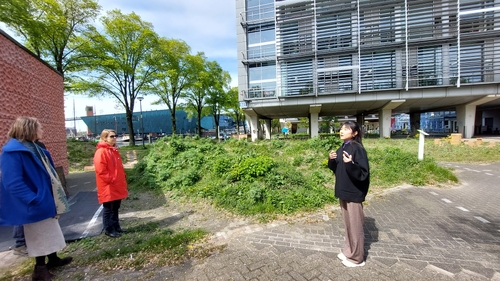
After this introduction the group went inside to dive deeper into the fenomonon of biophilia. Origins of the concept of biophelia can be found 300 BC by Aristotle. Through the ages the concept evaluated. The researches use the definition by E.O. Wilson (1984):
'Biophilia is our innate tendency to focus on life and lifelike forms to affiliate with them emotionally.'
The researches also adress the related concepts of biophilic urbanism and biophilic cities. The first is understood as 'a creative mix of green urban design with a commitment to outdoor life and the protection of restoration of green infrastructure from the bioregional to the neighborhood level' (Beatley, 2009). And when do we speak of biophilic cities? When 'Cities that put nature first in it's design, planning and management, they recognize the essential need for daily human contact with nature as well as the many enivronmental and economic values provided by nature' (Beatley, 2009).
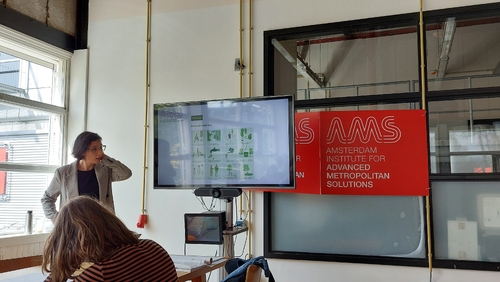
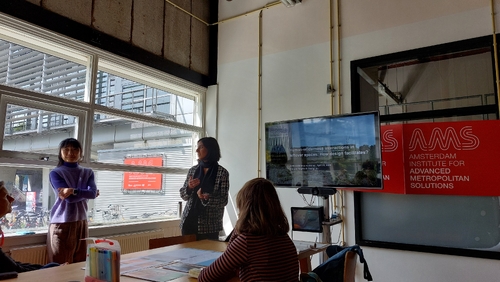
After the presentation the participants splitted into two groups. The first group reflected on real-life biophilia experience, using the '5 Ws & H' framework. They reflected on different dimensions of biophilia; (1) Physical Health, (2) Psychological Wellbeing, (3) Social and (4) Environmental. For each dimension they described the experience and the related benefits they gained. Afterwards they plotted the experiences on the map of Amsterdam. When the group was done, the researchers noticed a biase; all the experiences described by the participants were positively framed.
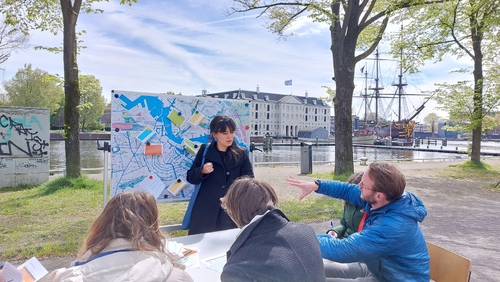
In the second group, te participants had an assignment to work with a map of that territory. To facilitate the process, six design patterns were made out to participants. Next, participants could draw on maps their vision of the implementation of suggested design patterns into the territory. After the quick co-creation session, participants discussed with the workshop organisers their vision of improving the living lab territory.
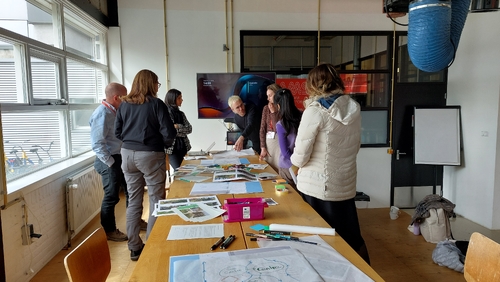
Pictures were taken during the Workshop Living nature in the city: How to experience Biophilia via Urban Living Labs | AMS Institute Scientific Conference Reinfent the City (23/04/2024)
Afbeelding credits
Icon afbeelding: Scientific Conference AMS-Institute 23/04/2024 | Presentation Workshop Living Nature in the City